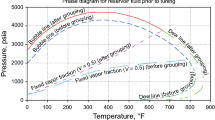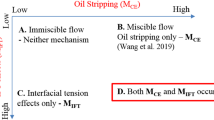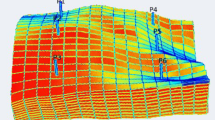Abstract
In CO2-enhanced oil recovery (CO2EOR) processes, the gas–oil interfacial tension (IFT), which is a key property to determining oil recovery factor, affects rock wettability, capillary pressure, relative permeability, oil flow, and oil recovery factor (RF). The IFT is a key property when addressing the flow assurance issues in CO2EOR processes, in which methane-rich gases mix with CO2 for injection. Although the literature reports some studies on the effect of methane concentration on the properties of CO2–oil systems, investigating methane content effects on IFT and fluid flow is still lacking, which is the primary motivation for the present work. Compositional simulations were carried out to evaluate the behavior of density, pressure, phase composition, oil saturation, IFT, and oil recovery to verify the effect in the IFT considering flow for different scenarios with varying methane concentration, pressure, and flow rate. The main focus is on the variation of these properties with IFT and their mechanisms. The results show how the methane content alters the CO2 dissolution in oil, the light hydrocarbon extraction from the oil, the reservoir pressure, the phase densities, the oil saturation, the gas–oil IFT, and the RF. At the beginning of the process, an optimal methane concentration provides the maximum RF. However, the EOR process achieves the highest recovery in the long term by injecting only CO2.






Similar content being viewed by others
Data availability
No data was used for the research described in the article.
References
Abdullah N, Hasan N (2021) Effects of miscible CO2 injection on production recovery. J Pet Explor Prod Technol 11(9):3543–3557. https://doi.org/10.1007/s13202-021-01223-0
Abedini A, Mosavat N, Torabi F (2014) Determination of minimum miscibility pressure of crude Oil-CO2 system by oil swelling/extraction test. Energy Technol 2(5):431–439. https://doi.org/10.1002/ente.201400005
Alotaibi MB, Nasr-El-Din HA (2009) Effect of brine salinity on reservoir fluids interfacial tension. Society of Petroleum Engineers - EUROPEC/EAGE Conference and Exhibition 2009, June, 8–11. https://doi.org/10.2118/121569-MS
Cahn JW, Hilliard JE (1958) Free energy of a nonuniform system. I. Interfacial free energy. J Chem Phys 28(2):258–267. https://doi.org/10.1063/1.1744102
Carvalhal AS, Costa GMN, de Melo SABV (2019) Simulation of enhanced oil recovery in pre-salt reservoirs: The effect of high CO2 content on low salinity water alternating gas injection. Society of Petroleum Engineers - Reservoir Characterisation and Simulation Conference and Exhibition 2019, September, 17–19. https://doi.org/10.2118/196684-ms
Cheng P, Li D, Boruvka L, Rotenberg Y, Neumann AW (1990) Automation of axisymmetric drop shape analysis for measurements of interfacial tensions and contact angles. Colloids Surf 43(2):151–167. https://doi.org/10.1016/0166-6622(90)80286-D
Cho J, Park G, Kwon S, Lee KS, Lee HS, Min B (2020) Compositional modeling to analyze the effect of CH4 on coupled carbon storage and enhanced oil recovery process. Appl Sci 10:4272. https://doi.org/10.3390/app10124272
Choubineh A, Helalizadeh A, Wood DA (2019) The impacts of gas impurities on the minimum miscibility pressure of injected CO2-rich gas–crude oil systems and enhanced oil recovery potential. Pet Sci 16(1):117–126. https://doi.org/10.1007/s12182-018-0256-8
Christensen JR, Stenby EH, Skauge A (2001) Review of WAG field experience. SPE Reserv Eval Eng 4(02):97–106. https://doi.org/10.2118/71203-PA
Drexler S, Correia EL, Jerdy AC, Cavadas LA, Couto P (2020) Effect of CO2 on the dynamic and equilibrium interfacial tension between crude oil and formation brine for a deepwater pre-salt field. J Petrol Sci Eng. https://doi.org/10.1016/j.petrol.2020.107095
Firoozabadi A, Katz DL, Soroosh H, Sajjadian VA (1988) Surface tension of reservoir crude–oil/gas systems recognizing the asphalt in the heavy fraction. SPE Reserv Eng 3(01):265–272. https://doi.org/10.2118/13826-PA
Gajbhiye R (2020) Effect of CO2/N2 mixture composition on interfacial tension of crude oil. ACS Omega 5(43):27944–27952. https://doi.org/10.1021/acsomega.0c03326
Ghaffar A (2016) Role of impurities in CO2 stream during CO2 injection process in heavy oil systems. 145. http://ourspace.uregina.ca/handle/10294/6824
Green DW, Willhite GP (2018) Enhanced oil recovery system. Richardson, Texas
Gu Y, Hou P, Luo W (2013) Effects of four important factors on the measured minimum miscibility pressure and first-contact miscibility pressure. J Chem Eng Data 58(5):1361–1370. https://doi.org/10.1021/je4001137
Hashemi Fath A, Pouranfard AR (2014) Evaluation of miscible and immiscible CO2 injection in one of the Iranian oil fields. Egypt J Pet 23(3):255–270. https://doi.org/10.1016/j.ejpe.2014.08.002
Hemmati-Sarapardeh A, Ayatollahi S, Ghazanfari MH, Masihi M (2014) Experimental determination of interfacial tension and miscibility of the CO2-crude oil system; temperature, pressure, and composition effects. J Chem Eng Data 59(1):61–69. https://doi.org/10.1021/je400811h
Islam MR (2019) Greening of enhanced oil recovery. Economically and environmentally sustainable enhanced oil recovery. Scrivener, Beverly, pp 525–662. https://doi.org/10.1002/9781119479239.ch7
Jin L, Pekot LJ, Hawthorne SB, Gobran B, Greeves A, Bosshart NW, Jiang T, Hamling JA, Gorecki CD (2017) Impact of CO2 impurity on MMP and Oil Recovery performance of the Bell Creek Oil Field. Energy Procedia 114:6997–7008. https://doi.org/10.1016/J.EGYPRO.2017.03.1841
Killough JE, Kossack CA (1987) Fifth comparative solution project: evaluation of miscible flood simulators. In SPE Symposium on Reservoir Simulation (p. SPE-16000-MS). https://doi.org/10.2118/16000-MS
Ligero EL (2011a) ATCE 2011: Emprego de CO 2 em Métodos de EOR e seu Efeito em Carbonatos UNISIM ON-LINE. https://www.unisim.cepetro.unicamp.br/online/UNISIM_ON_LINE_N62.PDF
Ligero EL (2011b) Modelagem Trifásica da Histerese na Simulação Composicional da Injeção WAG-CO2. UNISIM ON-LINE, 1(7). https://www.unisim.cepetro.unicamp.br/online/UNISIM_ON_LINE_N83.PDF
Nobakht M, Moghadam S, Gu Y (2007) Effects of viscous and capillary forces on CO2 enhanced oil recovery under reservoir conditions. Energy Fuels 21(6):3469–3476. https://doi.org/10.1021/ef700388a
Pereira LMC (2016) Interfacial tension of reservoir fluids: an integrated experimental and modelling investigation. July, p 215. http://hdl.handle.net/10399/3207
Perera MSA, Gamage RP, Rathnaweera TD, Ranathunga AS, Koay A, Choi X (2016) A Review of CO2-Enhanced oil recovery with a simulated sensitivity analysis. Energies 9(7):481. https://doi.org/10.3390/en9070481
Sequeira DS, Ayirala SC, Rao DN (2008) Reservoir condition measurements of compositional effects on gas–oil interfacial tension and miscibility. Society of Petroleum Engineers - Symposium on Improved Oil Recovery 2008, April, 20–23. https://doi.org/10.2118/113333-MS
Shang Q, Xia S, Shen M, Ma P (2014) Experiment and correlations for CO2–oil minimum miscibility pressure in pure and impure CO2 streams. RSC Adv 4(109):63824–63830. https://doi.org/10.1039/c4ra11471j
Shokrollahi A, Arabloo M, Gharagheizi F, Mohammadi AH (2013) Intelligent model for prediction of CO2–Reservoir oil minimum miscibility pressure. Fuel 112:375–384. https://doi.org/10.1016/J.FUEL.2013.04.036
Weinaug CF, Katz DL (1943) Surface tensions of methane-propane mixtures. Ind Eng Chem 35(2):239–246. https://doi.org/10.1021/ie50398a028
Zanganeh P, Ayatollahi S, Alamdari A, Zolghadr A, Dashti H, Kord S (2012) Asphaltene deposition during CO2 injection and pressure depletion: a visual study. Energy Fuels 26(2):1412–1419. https://doi.org/10.1021/ef2012744
Zhang PY, Huang S, Sayegh S, Zhou XL (2004) Effect of CO2 Impurities on gas-injection EOR processes. SPE/DOE Symposium on Improved Oil Recovery 2004, April, 17–21. https://doi.org/10.2118/89477-MS
Zhang K, Tian L, Liu L (2018) A new analysis of pressure dependence of the equilibrium interfacial tensions of different light crude oil–CO2 systems. Int J Heat Mass Transf 121:503–513. https://doi.org/10.1016/J.IJHEATMASSTRANSFER.2018.01.014
Zhao Y, Yu Q (2018) Effect of CH4 on the CO2 breakthrough pressure and permeability of partially saturated low-permeability sandstone in the Ordos Basin, China. J Hydrol. https://doi.org/10.1016/j.jhydrol.2017.11.030
Zick AA (1986) Combined condensing/vaporizing mechanism in the displacement of oil by enriched gases. Society of Petroleum Engineers - Annual Technical Conference and Exhibition October, 1986, 5–8. https://doi.org/10.2523/15493-ms
Zuo YX, Stenby EH (1996) A linear gradient theory model for calculating interfacial tensions of mixtures. J Colloid Interface Sci 182(1):126–132. https://doi.org/10.1006/JCIS.1996.0443
Zuo YX, Stenby EH (1997) Corresponding-States and Parachor Models for the calculation of interfacial tensions. Can J Chem Eng 75(6):1130–1137. https://doi.org/10.1002/cjce.5450750617
Acknowledgements
The authors acknowledge the support by the Agência Nacional de Petróleo, Gás Natural e Biocombustíveis (ANP), and the Petrogal Brasil S.A., related to the grant from the research and development rule, as well as the Engineer Juan Alberto Mateo Hernandez (CMG).
Author information
Authors and Affiliations
Corresponding author
Ethics declarations
Conflict of interest
On behalf of all authors, the corresponding author states that there is no conflict of interest.
Additional information
Publisher’s Note
Springer Nature remains neutral with regard to jurisdictional claims in published maps and institutional affiliations.
Electronic supplementary material
Below is the link to the electronic supplementary material.
Rights and permissions
Springer Nature or its licensor (e.g. a society or other partner) holds exclusive rights to this article under a publishing agreement with the author(s) or other rightsholder(s); author self-archiving of the accepted manuscript version of this article is solely governed by the terms of such publishing agreement and applicable law.
About this article
Cite this article
Dantas, P.H.A., dos Santos, A.L.N., Lins, I.E.S. et al. Assessing the effects of CO2/methane mixtures on gas−oil interfacial tension and fluid flow using compositional simulation. Braz. J. Chem. Eng. (2023). https://doi.org/10.1007/s43153-023-00329-8
Received:
Revised:
Accepted:
Published:
DOI: https://doi.org/10.1007/s43153-023-00329-8




